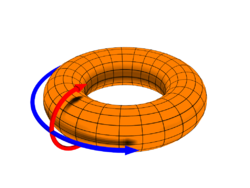
In a toroidal fusion power reactor, the magnetic fields confining the plasma are formed in a helical shape, winding around the interior of the reactor. The safety factor, labeled q or q(r), is the ratio of the times a particular magnetic field line travels around a toroidal confinement area's "long way" (toroidally) to the "short way" (poloidally).
The term "safety" refers to the resulting stability of the plasma; plasmas that rotate around the torus poloidally about the same number of times as toroidally are inherently less susceptible to certain instabilities. The term is most commonly used when referring to tokamak devices. Although the same considerations apply in stellarators, by convention the inverse value is used, the rotational transform, or i.
The concept was first developed by Martin David Kruskal and Vitaly Shafranov, who noticed that the plasma in pinch effect reactors would be stable if q was larger than 1. Macroscopically, this implies that the wavelength of the potential instability is longer than the reactor. This condition is known as the Kruskal–Shafranov limit.
© MMXXIII Rich X Search. We shall prevail. All rights reserved. Rich X Search



